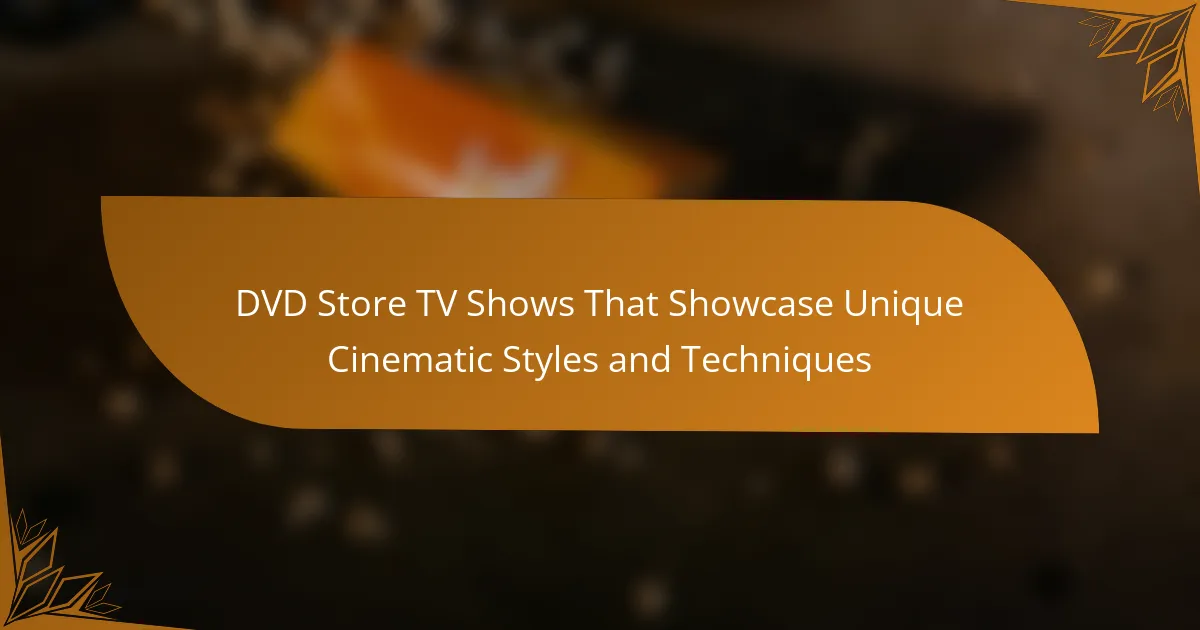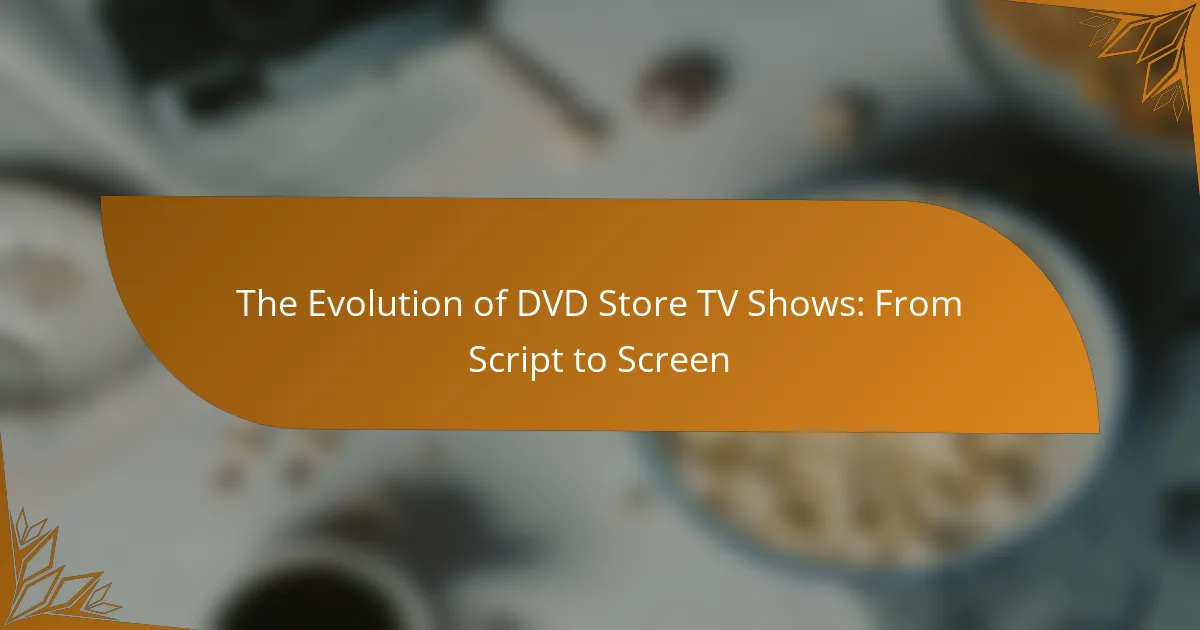The article focuses on DVD store TV shows that showcase unique cinematic styles and techniques, highlighting notable examples such as “Fargo,” “Twin Peaks,” “Breaking Bad,” and “The Handmaid’s Tale.” Each show is recognized for its innovative storytelling, employing distinct visual aesthetics, narrative structures, and thematic elements. “Fargo” features dark humor and nonlinear narratives, while “Twin Peaks” is celebrated for its surreal visuals. “Breaking Bad” utilizes color symbolism and dynamic camera angles, and “The Handmaid’s Tale” conveys powerful themes through stark visuals and symbolism. The article also emphasizes how viewers can enhance their appreciation of these shows by analyzing visual storytelling elements, editing styles, and the cultural context surrounding them.
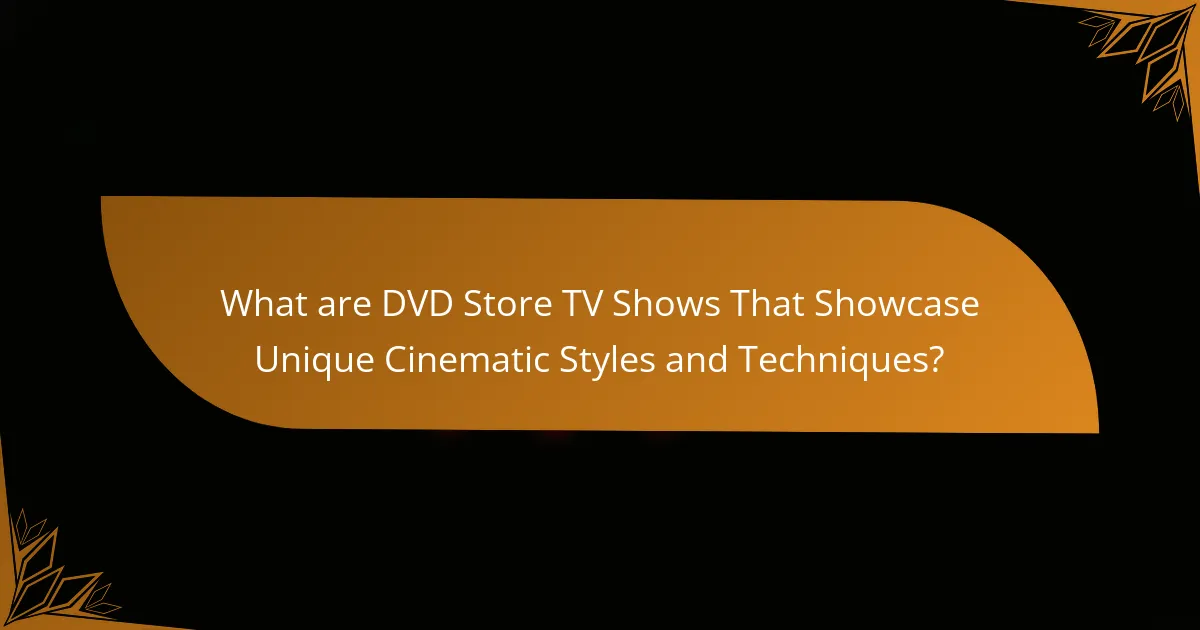
What are DVD Store TV Shows That Showcase Unique Cinematic Styles and Techniques?
“DVD Store TV Shows that showcase unique cinematic styles and techniques include ‘Fargo’, ‘Twin Peaks’, and ‘The Handmaid’s Tale’. ‘Fargo’ employs a distinctive storytelling style with dark humor and nonlinear narratives. ‘Twin Peaks’ is known for its surreal visuals and unconventional narrative structure. ‘The Handmaid’s Tale’ utilizes a stark visual aesthetic and powerful symbolism to convey its themes. Each show has received critical acclaim for its artistic approach and innovation in storytelling.”
How do these shows differ from traditional television programming?
These shows differ from traditional television programming in their narrative structure and production style. They often employ unconventional storytelling techniques, such as non-linear timelines or experimental visuals. Traditional television typically follows a more linear narrative arc and standardized production values. Furthermore, these shows often prioritize artistic expression over commercial viability. They may explore niche themes and character development in greater depth. This contrasts with traditional programming, which often aims for broader audience appeal. The unique cinematic styles can include distinctive cinematography and innovative editing techniques. This creative approach enhances viewer engagement and fosters a more immersive experience.
What unique cinematic styles are commonly featured in these shows?
Unique cinematic styles featured in these shows include non-linear storytelling and visual symbolism. Non-linear storytelling disrupts chronological order to enhance narrative depth. This style engages viewers by presenting events out of sequence. Visual symbolism uses imagery to convey deeper meanings. This technique enriches the viewer’s experience through subtle cues. Shows like “Breaking Bad” and “The Sopranos” exemplify these styles. They utilize complex character arcs and thematic elements effectively. The use of unique camera angles also adds to the cinematic experience. Techniques like long takes and close-ups create emotional intensity.
How do these techniques enhance storytelling in the shows?
Techniques such as non-linear storytelling and visual symbolism enhance storytelling in shows by creating deeper emotional connections. Non-linear storytelling allows viewers to experience events out of chronological order. This technique can build suspense and intrigue, keeping audiences engaged. Visual symbolism adds layers of meaning to the narrative. It encourages viewers to interpret themes and character motivations more profoundly. For example, a recurring motif might symbolize a character’s internal struggle. These techniques can transform a straightforward plot into a rich, multifaceted experience. They invite viewers to actively participate in deciphering the story, enhancing overall engagement.
Why are unique cinematic styles important in television shows?
Unique cinematic styles are important in television shows because they enhance storytelling and viewer engagement. These styles create a distinct visual identity that sets a show apart. For instance, shows like “Breaking Bad” use color grading to symbolize character development. Unique styles can also evoke specific emotions, making scenes more impactful. Research indicates that visual storytelling can significantly affect audience retention and emotional response. According to a study by the University of Southern California, unique cinematography increases viewer investment in the narrative. This investment often leads to a stronger connection with characters and themes. Therefore, unique cinematic styles are crucial for creating memorable television experiences.
What impact do these styles have on viewer engagement?
Unique cinematic styles significantly enhance viewer engagement. These styles create immersive experiences that captivate audiences. Techniques like unconventional storytelling, striking visuals, and innovative editing draw viewers in. Research shows that shows with unique styles often retain higher audience attention. For example, series like “Breaking Bad” and “Fargo” utilize distinctive cinematography to maintain viewer interest. This results in increased emotional investment and discussion among viewers. Engaging styles also encourage social sharing and recommendations, further boosting viewership. Thus, unique cinematic styles are crucial for fostering strong viewer engagement.
How do they contribute to the overall aesthetic of a show?
They contribute to the overall aesthetic of a show by enhancing visual storytelling. Unique cinematic styles create a distinctive atmosphere that engages viewers. Techniques such as color grading, camera angles, and lighting shape the mood. For instance, a dark color palette can evoke tension. Conversely, bright colors may convey joy or whimsy. Specific techniques like slow motion emphasize critical moments. These elements work together to create a cohesive visual identity. Shows like “Breaking Bad” and “The Handmaid’s Tale” exemplify this through their unique aesthetics. Their styles significantly influence audience perception and emotional response.
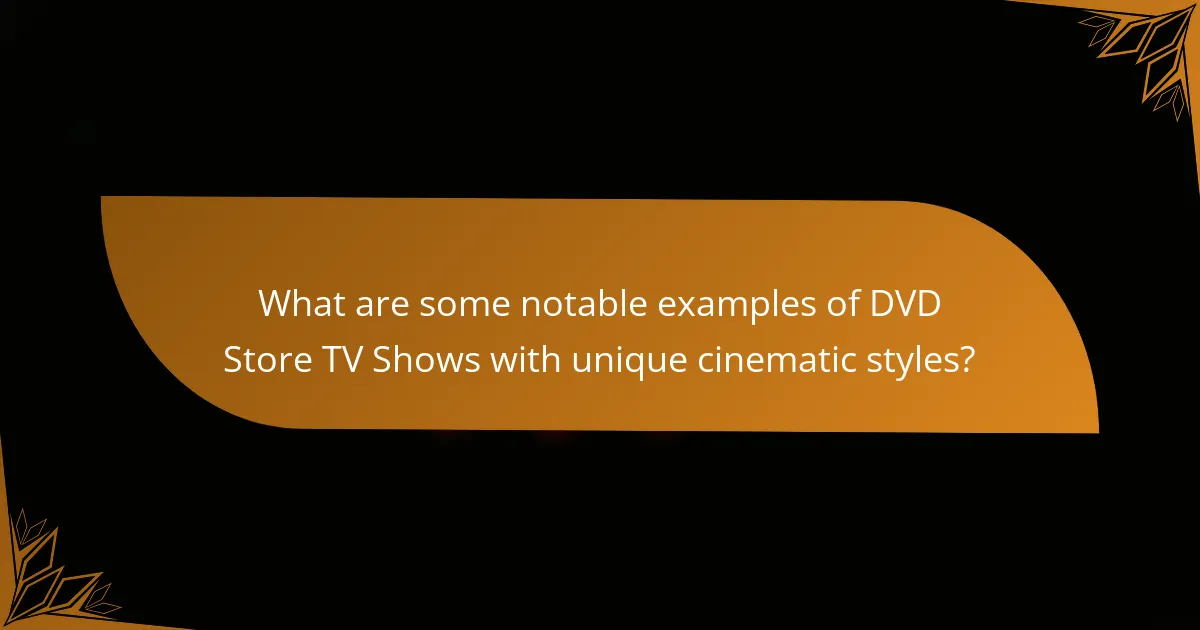
What are some notable examples of DVD Store TV Shows with unique cinematic styles?
Notable examples of DVD Store TV shows with unique cinematic styles include “Breaking Bad,” “Fargo,” and “The Handmaid’s Tale.” “Breaking Bad” utilizes a distinctive visual storytelling approach with its color symbolism and dynamic camera angles. “Fargo” employs a mix of dark humor and stark visuals, reflecting its Midwestern setting. “The Handmaid’s Tale” features a haunting aesthetic, using color palettes to convey emotional depth. Each show has garnered critical acclaim for its innovative use of cinematography and narrative structure, setting them apart in the realm of television.
Which shows are recognized for their innovative visual techniques?
Shows recognized for their innovative visual techniques include “Breaking Bad,” “Game of Thrones,” and “The Mandalorian.” “Breaking Bad” is renowned for its use of color symbolism and unique camera angles. “Game of Thrones” is noted for its epic battle sequences and extensive use of CGI. “The Mandalorian” pioneered the use of virtual production technology with its StageCraft system. These shows have received critical acclaim for pushing the boundaries of visual storytelling in television.
What specific cinematic styles are employed in these examples?
The specific cinematic styles employed in these examples include realism, expressionism, and surrealism. Realism is characterized by its focus on everyday life and authentic representation of characters and settings. This style often uses natural lighting and location shooting to enhance its authenticity. Expressionism emphasizes emotional experience over physical reality, often utilizing dramatic lighting and distorted sets. Surrealism explores dream-like sequences and illogical scenes, creating a sense of the uncanny. These styles are evident in various TV shows available in DVD stores, showcasing unique techniques that engage viewers.
How do these shows utilize cinematography to tell their stories?
These shows utilize cinematography to enhance their storytelling by employing visual techniques that evoke emotions and establish tone. They often use composition, lighting, and camera movement to create a specific atmosphere. For instance, close-up shots can convey intimacy or tension, while wide shots can establish context or isolation. Dynamic camera movements, such as tracking or panning, can heighten drama or provide a sense of urgency. Color palettes are carefully chosen to reflect characters’ emotions or themes, influencing viewers’ perceptions. Additionally, the use of depth of field can direct audience focus to key elements, enhancing narrative clarity. This strategic use of cinematography serves to immerse viewers in the story, making the visual experience integral to understanding the plot and character development.
What themes are commonly explored in these unique shows?
Common themes explored in unique shows include identity, societal issues, and existentialism. These themes often challenge viewers to reflect on personal and collective experiences. Identity is frequently portrayed through character development and transformation. Societal issues are depicted via narratives that critique cultural norms and injustices. Existentialism is explored through characters facing moral dilemmas and the search for meaning. Shows like “Black Mirror” and “Fargo” exemplify these themes, weaving complex storylines that provoke thought and discussion. Such thematic depth enhances viewer engagement and fosters critical thinking.
How do these themes relate to the style of cinematography used?
Themes in TV shows significantly influence cinematography style. For instance, a theme of isolation might lead to tight framing and muted colors. This approach visually represents characters’ emotional states. Conversely, themes of adventure may employ wide shots and vibrant colors to convey excitement. The choice of camera angles also reflects thematic elements. Low angles can depict power, while high angles suggest vulnerability. Additionally, lighting techniques align with themes; dark lighting may enhance suspense, while bright lighting can evoke joy. Overall, cinematography serves as a visual language that reinforces the show’s themes and emotional impact.
What role does visual storytelling play in conveying these themes?
Visual storytelling plays a crucial role in conveying themes in TV shows. It enhances narrative depth by using imagery to evoke emotions. This method allows viewers to connect with characters on a personal level. For example, color palettes can symbolize mood shifts or character development. Cinematic techniques, such as framing and camera angles, emphasize key moments. These visual elements help to convey complex themes without relying solely on dialogue. Research indicates that visual storytelling increases viewer engagement and retention. A study by the University of California found that visuals improve memory recall by 65%. Thus, visual storytelling is essential for effectively communicating themes in television.
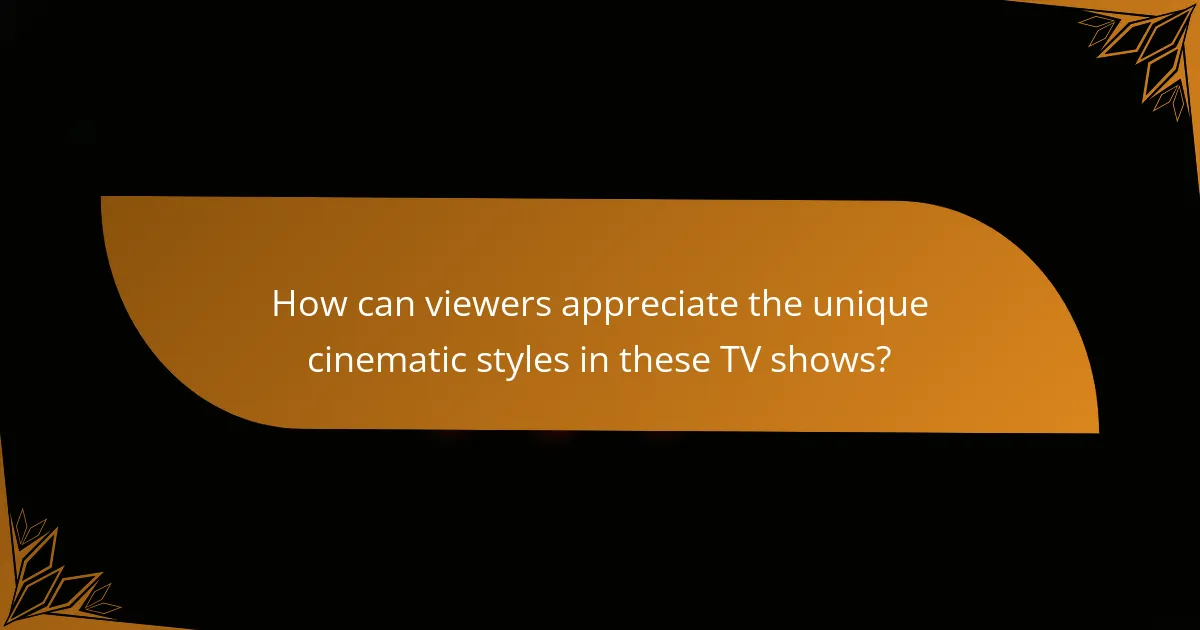
How can viewers appreciate the unique cinematic styles in these TV shows?
Viewers can appreciate unique cinematic styles in TV shows by actively observing visual storytelling techniques. This includes analyzing camera angles, lighting, and color palettes. For example, shows like “Breaking Bad” use color symbolism to enhance character development. Viewers should also pay attention to editing styles that create pacing and tension. The use of non-linear narratives, as seen in “Westworld,” adds complexity to storytelling. Engaging with behind-the-scenes content can provide insights into creative choices made by directors and cinematographers. Understanding the cultural context of the shows can further enhance appreciation. These elements combined help viewers recognize and value the artistry in cinematic styles.
What tips can enhance the viewing experience of these shows?
To enhance the viewing experience of shows that showcase unique cinematic styles and techniques, consider optimizing your viewing environment. A dark room minimizes distractions and enhances visual clarity. Using a high-definition screen improves detail and color accuracy. Surround sound systems create an immersive audio experience. Watching with subtitles can improve comprehension of dialogue and artistic nuances. Engaging with supplementary materials, like director’s commentaries, provides deeper insights into the creative process. Scheduling viewing sessions during quiet times reduces interruptions. Finally, discussing episodes with friends or online communities can enrich understanding and enjoyment.
How can viewers analyze the cinematography while watching?
Viewers can analyze cinematography while watching by paying attention to visual composition. They should observe framing, camera angles, and shot types. Noticing lighting and color palettes also enhances understanding. Examining movement within scenes, such as camera tracking, is crucial. Viewers can assess how these elements convey mood and tone. Comparing scenes for consistency in style aids analysis. Recognizing the use of visual storytelling techniques deepens appreciation. Research shows that engaged viewing improves comprehension of cinematographic choices.
What resources are available for deeper understanding of these styles?
Books on film theory provide foundational knowledge. “Film Art: An Introduction” by Bordwell and Thompson is a key resource. Online courses on platforms like Coursera and MasterClass offer structured learning. Websites such as IndieWire and No Film School feature articles on unique cinematic styles. Documentaries about filmmaking, like “Side by Side,” explore various techniques. Film festivals often have workshops and panels discussing innovative styles. Scholarly articles in journals like “Film Quarterly” provide in-depth analysis. These resources enhance understanding of cinematic styles and techniques.
What are some common misconceptions about unique cinematic styles in TV shows?
One common misconception about unique cinematic styles in TV shows is that they are solely for artistic expression. Many believe these styles do not impact storytelling. However, unique styles often enhance narrative depth and character development. For example, shows like “Breaking Bad” use color grading to symbolize character transformation. Another misconception is that unique styles alienate audiences. In reality, they can create emotional connections. A study by the University of Southern California found that viewers engage more with visually distinctive storytelling. Lastly, some think unique styles are only present in high-budget productions. Many low-budget shows successfully employ innovative techniques, proving that creativity matters more than budget.
How do these misconceptions affect viewer perception?
Misconceptions about DVD store TV shows can significantly distort viewer perception. They may lead audiences to underestimate the artistic value of these shows. Viewers might assume that such shows lack depth or innovation. This assumption can result in a reluctance to engage with the content.
As a consequence, audiences may miss out on unique cinematic styles and techniques. For instance, shows that utilize unconventional storytelling may be overlooked. This can perpetuate a cycle where only mainstream productions receive attention. Ultimately, misconceptions create barriers to appreciating diverse narratives and artistic expressions.
What truths can clarify the value of these styles in storytelling?
Unique cinematic styles enhance storytelling by creating distinct narrative experiences. They engage audiences through innovative visual techniques. These styles can evoke specific emotions and reactions. For instance, non-linear storytelling can build suspense and intrigue. Visual styles like color grading can set the tone and atmosphere. Techniques such as breaking the fourth wall can create intimacy with viewers. Historical examples include “Pulp Fiction” and its non-linear narrative. Research shows that unique styles can increase viewer retention and satisfaction.
DVD Store TV Shows that showcase unique cinematic styles and techniques include critically acclaimed series such as “Fargo,” “Twin Peaks,” and “The Handmaid’s Tale.” These shows are distinguished by their unconventional storytelling methods, such as non-linear narratives and striking visual symbolism, which enhance viewer engagement and emotional connections. The article explores how these unique styles differ from traditional television programming, their impact on storytelling and viewer experience, and notable examples that exemplify innovative visual techniques. Additionally, it addresses common misconceptions regarding the artistic value of these styles and their significance in enhancing narrative depth.
